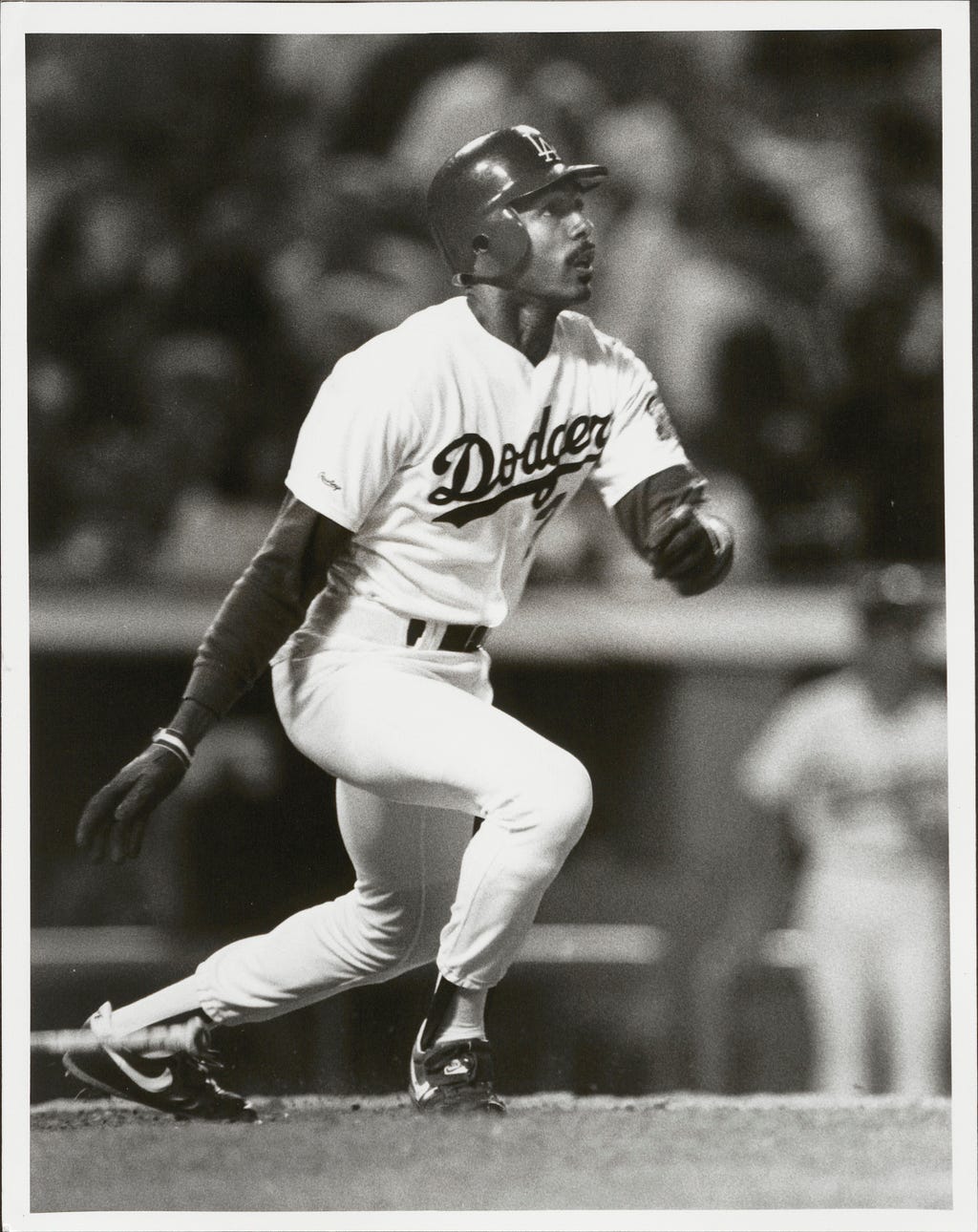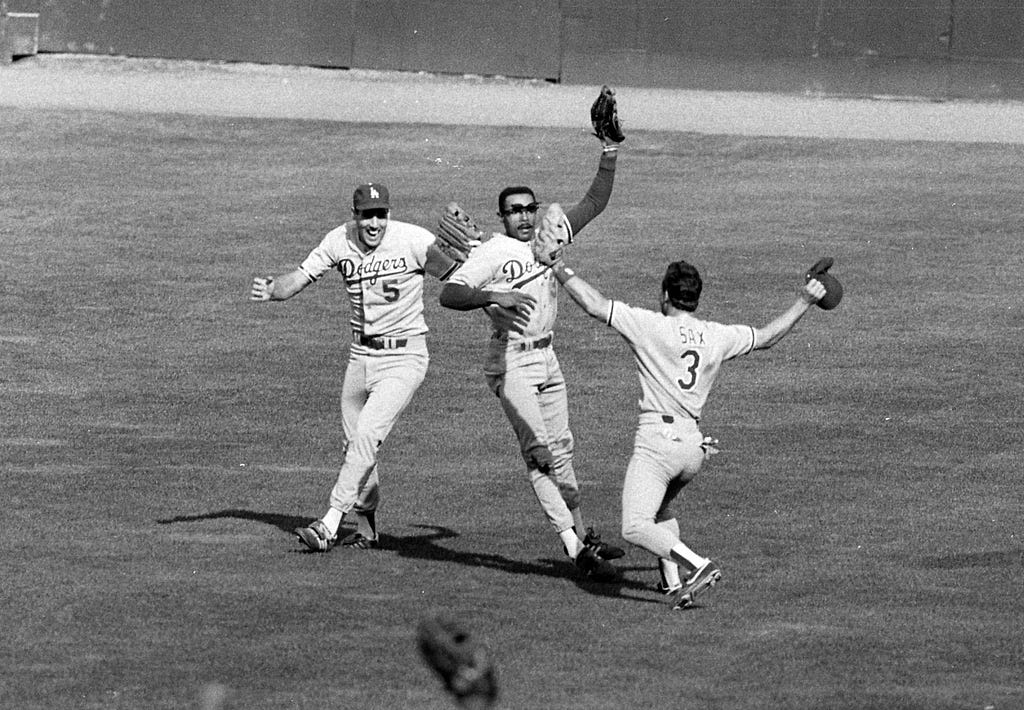
by Mark Langill
His hitting, fielding and speed led the Dodgers to acquire center fielder John Shelby from the Baltimore Orioles’ Triple-A Rochester affiliate early in the 1987 season. The May 22 transaction caused barely a ripple in baseball circles, something that needed time to appreciate.
One year later, Shelby played a key role in the Dodgers winning a World Series title.
Unsurprisingly, Shelby’s defense saved Los Angeles in the 1988 National League Championship Series with two game-ending catches against the Mets. The The 6-foot-1, 175-pound Kentucky native remained aggressive, even after dropping a ninth-inning fly ball on a diving attempt of Gary Carter’s low line drive that became a two-run double gave New York a 3–2 victory in Game 1 at Dodger Stadium.
But it was Shelby’s patience at the plate — not exactly the trademark of a player with a career .281 on-base percentage— during another ninth-inning drama that ultimately led to arguably one of the most important walks in the history of the Dodger franchise.
The Dodgers were on the verge of falling behind 3–1 in the best-of-seven series in Game 4. Mets right-hander Dwight Gooden was cruising with a 4–2 lead entering the ninth inning at Shea Stadium. At that point, the former NL Rookie of the Year and Cy Young Award recipient had 18 strikeouts in two starts against the Dodgers, one shy of Mike Scott’s 1986 NLCS record with the 1986 Astros.
Shelby was the leadoff hitter. He had two singles and a strikeout against Gooden in three previous at-bats. Gooden, who had eight strikeouts and four walks in eight innings, had not allowed a hit since Shelby’s leadoff single in the fourth inning.
The crowd of 54,104, chanting “Beat L.A.,” anticipated a strikeout when Shelby quickly fell behind 0–2 in the count on a foul ball and a called second strike by home plate umpire Dutch Rennert.
Shelby watched Gooden’s third pitch sail high and he fouled off the fourth. After talking another low pitch to make it 2–2, he stayed alive with a check-swing foul.
“I knew I needed to get on base any way I could,” Shelby said Tuesday from his home in Sarasota, Florida. “It was always tempting to swing at high fastballs from Gooden. In that at-bat, I knew the pitches that I took were out of the strike zone. When the count went to 3-and-2, I said to myself, ‘Make sure the ball is low’ because I knew they were pitching me high.”
Shelby walked on the eighth pitch of the at-bat.
Shelby’s walk became the first of several falling dominoes that still resonate 36 years later with both teams.
Catcher Mike Scioscia, who had only three home runs in 408 at-bats during the regular season, pulled Gooden’s first pitch into the Mets bullpen to make the score 4–4.
“When I went around the bases, I could hear my cleats hitting the dirt because the stadium was so quiet,” Scioscia said in 2018.
Kirk Gibson’s solo home run off Roger McDowell in the 12th inning gave Los Angeles a 5–4 lead.
The Dodgers, though, didn’t have reliever Jay Howell available. The closer was suspended for three days by National League President Bart Giamatti after getting caught with too much pine tar on his glove while trying to protect a 4–3 lead in the eighth inning of Game 3. Howell’s ejection was part of New York’s five-run rally and subsequent 8–4 victory.

On the ropes in Game 4, the Dodgers fought back with a surprise knockout blow.
Without Howell, the Dodger pitching was thin during extra innings. Right-hander Tim Belcher was back at the team hotel, resting for his start in Game 5. Orel Hershiser, who had pitched seven innings the previous night in Game 3, went to the bullpen on his own.
Manager Tommy Lasorda didn’t consider using Hershiser until in the 12th he ran out of patience with left-hander Jesse Orosco. Orosco, the former Met who closed out New York’s 1986 World Series title against the Boston Red Sox, was brought into the game with one out and runners on second and third. Orosco walked Keith Hernandez to load the bases.
After Darryl Strawberry popped out to second baseman Steve Sax, Lasorda brought in his final pitcher — Hershiser, who retired Kevin McReynolds on a broken-bat blooper to Shelby, who made a basket catch on the run to save the 5–4 victory, knotting the series at two games apiece.
The 1988 season was the peak of Shelby’s career. He remained with the Dodgers until 1990 and played two seasons in Detroit. Shelby later returned to the Dodgers as a Minor League Manager and Major League coach.
Strawberry, the eight-time All-Star outfielder who played with both the Mets (1983–90) and Dodgers (1991–93) during his 17-year career, brought up Shelby’s NLCS Game 4 walk at his Citi Field press conference on Wednesday.
“I don’t know how Doc (Gooden) walked T-Bone Shelby,” Strawberry said, joking with Gooden. Both were part of Wednesday’s ceremonial first pitch at Citi Field. “All he had to do was bounce one up there.
“But it’s just the moment. It’s the moment you’re in and everything. See, we can reflect back because we know we were right in it. And it was heartbreaking to be able to go through that and see Scioscia hit that big home run.”
During the 1988 regular season, Shelby slashed .263/.320/.395/.715 with 10 home runs, 64 RBI, 128 strikeouts and 44 walks in 140 games.
“That was John rising to the moment,” says Fred Claire, the former Dodger general manager who traded for Shelby based on a report from scout Mel Didier, who watched Shelby at Triple-A Rochester. “If you looked at his walk totals for each year, it was never a high number. Yes, he had a relatively low on-base percentage. But it’s the players in the moments, and that was a very important play.”
The 1988 Mets beat Dodgers in 10 of 11 meetings during the regular season. The mismatch on paper turned into an unlikely ending when the Dodgers outlasted the Mets, winning the decisive Game 7, 6–0, behind Hershiser’s complete game at Dodger Stadium.
Without Shelby’s walk, Scioscia’s home run doesn’t tie the game. Without Scioscia’s home run, perhaps Gibson has no chance at walk-off heroics against the Athletics six days later with a pinch-hit home run in Game 1 of the 1988 World Series.
“But that’s what playoff baseball is all about,” Strawberry says. “Somebody is going to come up, somebody’s going to be in the situation and somebody is going to get a big hit. And it changes the situation of the game. That’s what it was for the Dodgers. And it changed that series for us. And they went on to beat us in the series.”
NLCS: One of the biggest walks in Dodger history was originally published in Dodger Insider on Medium, where people are continuing the conversation by highlighting and responding to this story.